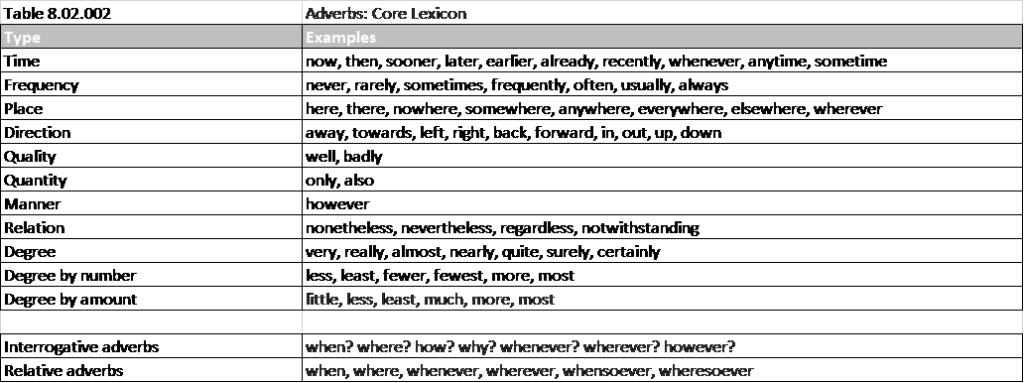Adjectives and adverbs function to qualify other terms; adjectives qualify nouns and adverbs qualify verbs, adjectives, other adverbs and occasionally prepositions. Both classes are extendible. In each case there is a relatively small core general purpose lexicon which changes rarely and a larger domain specific lexicon which is constantly being revised and updated.
Interrogative and relative adjectives and adverbs are dealt with more fully in sections 12 below which deals with questions and relative clauses.
Adjectives
Adjectives that restrict the target reference are now sometimes called determiners. Determiners narrow the target reference from the whole class of entities to a specific population or set of entities.

There are about 40 determiners in common usage. As a class of words, it is small and static. Unlike other adjectives, only one determiner can normally be used to qualify a particular noun. This is because multiple determiners would undermine the function of each. It is possible to have a sequence of determiners that more narrowly restricts the selection. For example, we can say I donated my books and I donated some books and we can also say I donated some of my books but to do this the noun has to wrapped in a prepositional phrase.
There are second, more emphatic forms, of whosever, whatever and whichever; namely whosesoever, whatsoever and whichsoever. These forms are rarely used today.
The wider class of adjectives function to describe the attributes of the entity or entities referred to. There is a core lexicon of about 60 general purpose adjectives plus some fairly stable categories such as numbers and colours.

Beyond these, there is a lexicon that is domain specific adjectives that are continually being created when new meanings are required. Adjectives can be formed from other classes of words through the use of suffixes. Contrary adjectives are often formed with the prefixes un-, in-, im-, ir-, il-, mis– and dis-. There are generally two reasons to use adjectives, firstly to provide additional information, providing background and colour, and secondly, to restrict the target reference. These could also be accomplished by using relative clauses (see section 12.2 below).

Adjectives can have both a comparative and superlative forms. The comparative form can be itself calibrated using general purpose adverbs. There are two forms, one used with single syllable adjectives and the other used with multi-syllabic adjectives.

The only statement component that an adjective cannot be part of is the verb. Because adjectives qualify nouns, they can be components of a subject, a complement, an object and a prepositional phrase and, because adjectives can be part of a prepositional phrase, they can also be present in an adverbial component (see section 9 below).
Adverbs
Adverb is something of a catch-all term for words that qualify verbs, adjectives and other adverbs. Adverbs can also be used to qualify prepositions. We can say, for example, they were more against than they were for the idea.
Adverbs as words should not be confused with adverb-terms as component types or adverbials as statement components. As adverbs qualify adjectives they can, like adjectives, be an element in every component of a statement except the verb term. At the same time, adverb-terms and adverbial components may be prepositional phrases which don’t contain any adverbs as such.
Not all adverbs admit of degrees, many adverbs, like adjectives, come in comparative and superlative forms. The comparative can be subject to additional calibration. The adverbs which are used to add a calibration can usually be calibrated themselves. As with adjectives, there are two forms, one for single syllable adverbs and the other for multi-syllable adverbs. Since many adverbs are formed from adjectives by the addition of the suffix –ly, most adverbs are calibrated using the second form.

Although adverbs are an extendible class of terms, there is a core lexicon of about 60 words that serve a general purpose and don’t change significantly.

The interrogative adverbs of direction whither and whence, meaning to where and from where, and the equivalents for here and there, namely hitherto and hither (to here) and henceforth and hence (from here) and thither (to there) and thence (from there), now sound dated and are usually replaced by the prepositional phrases.
Similarly, there are more emphatic forms of the adverbs whenever, wherever and however; namely, whensoever, wheresoever and howsoever, but these are rarely used.
